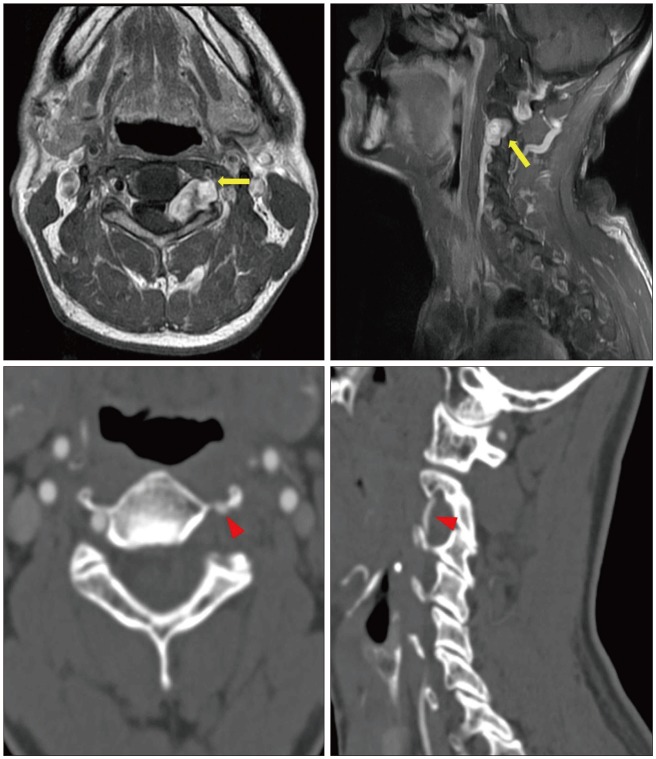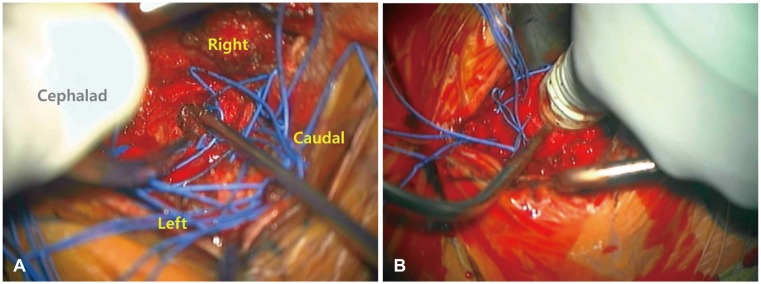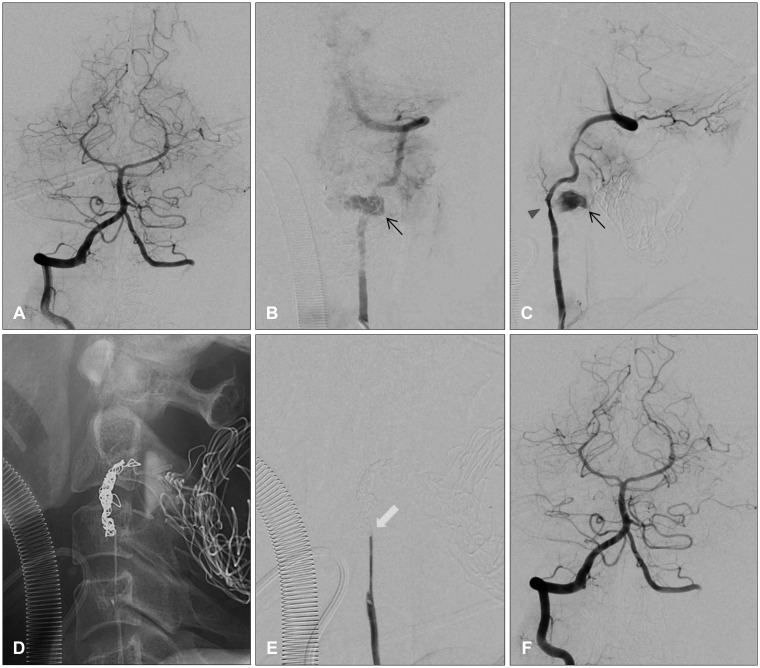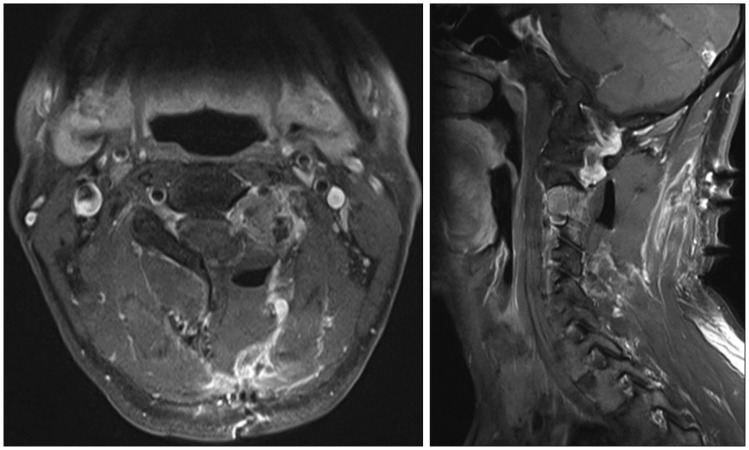Korean J Neurotrauma.
2017 Apr;13(1):39-44. 10.13004/kjnt.2017.13.1.39.
Vertebral Artery Injury in C2-3 Epidural Schwannoma Resection: A Case Report and Literature Review
- Affiliations
-
- 1Department of Neurological Surgery, Asan Medical Center, University of Ulsan College of Medicine, Seoul, Korea. scrhim@amc.seoul.kr
- KMID: 2378249
- DOI: http://doi.org/10.13004/kjnt.2017.13.1.39
Abstract
- The incidence of vertebral artery (VA) injury (VAI) in posterior approach tumor resection surgery is extremely rare, but it can lead to serious complication. In this case, a 57-year-old man underwent surgery for resection of the tumor involving left epidural space and neural foramen at C2-3 level. Iatrogenic VAI occurred suddenly during tumor resection procedure using pituitary forceps. Immediate local hemostasis and maintaining of perfusion for reducing the risk of posterior circulation ischemia were performed. Intraoperative angiogram of both VA and emergent trapping embolization were done as well. It may reduce the risk of immediate postop complication, and further delayed occurrence. The patient had no complication after VAI by appropriate intraoperative management. Preoperative angiographic work up and preparation of endovascular team cooperation are positively necessary as well as a warning for the VAI during cervical spine surgery.
MeSH Terms
Figure
Reference
-
1. Bertalanffy H, Eggert HR. Complications of anterior cervical discectomy without fusion in 450 consecutive patients. Acta Neurochir (Wien). 1989; 99:41–50. PMID: 2667284.
Article2. Bilbao G, Duart M, Aurrecoechea JJ, Pomposo I, Igartua A, Catalán G, et al. Surgical results and complications in a series of 71 consecutive cervical spondylotic corpectomies. Acta Neurochir (Wien). 2010; 152:1155–1163. PMID: 20443029.
Article3. Burke JP, Gerszten PC, Welch WC. Iatrogenic vertebral artery injury during anterior cervical spine surgery. Spine J. 2005; 5:508–514. discussion 514. PMID: 16153577.
Article4. Choi JW, Lee JK, Moon KS, Kim YS, Kwak HJ, Joo SP, et al. Endovascular embolization of iatrogenic vertebral artery injury during anterior cervical spine surgery: report of two cases and review of the literature. Spine (Phila Pa 1976). 2006; 31:E891–E894. PMID: 17077727.5. Cosgrove GR, Théron J. Vertebral arteriovenous fistula following anterior cervical spine surgery. Report of two cases. J Neurosurg. 1987; 66:297–299. PMID: 3806213.6. Diaz-Daza O, Arraiza FJ, Barkley JM, Whigham CJ. Endovascular therapy of traumatic vascular lesions of the head and neck. Cardiovasc Intervent Radiol. 2003; 26:213–221. PMID: 14562967.
Article7. Fountas KN, Kapsalaki EZ, Nikolakakos LG, Smisson HF, Johnston KW, Grigorian AA, et al. Anterior cervical discectomy and fusion associated complications. Spine (Phila Pa 1976). 2007; 32:2310–2317. PMID: 17906571.
Article8. Garcia Alzamora M, Rosahl SK, Lehmberg J, Klisch J. Life-threatening bleeding from a vertebral artery pseudoaneurysm after anterior cervical spine approach: endovascular repair by a triple stent-in-stent method. Case report. Neuroradiology. 2005; 47:282–286. PMID: 15789201.
Article9. Golfinos JG, Dickman CA, Zabramski JM, Sonntag VK, Spetzler RF. Repair of vertebral artery injury during anterior cervical decompression. Spine (Phila Pa 1976). 1994; 19:2552–2556. PMID: 7855680.
Article10. Graham AW, Swank ML, Kinard RE, Lowery GL, Dials BE. Posterior cervical arthrodesis and stabilization with a lateral mass plate. Clinical and computed tomographic evaluation of lateral mass screw placement and associated complications. Spine (Phila Pa 1976). 1996; 21:323–328. PMID: 8742208.11. Jeng JS, Yip PK. Evaluation of vertebral artery hypoplasia and asymmetry by color-coded duplex ultrasonography. Ultrasound Med Biol. 2004; 30:605–609. PMID: 15183225.
Article12. Katonis P, Papadakis SA, Galanakos S, Paskou D, Bano A, Sapkas G, et al. Lateral mass screw complications: analysis of 1662 screws. J Spinal Disord Tech. 2011; 24:415–420. PMID: 21150657.13. Madawi AA, Casey AT, Solanki GA, Tuite G, Veres R, Crockard HA. Radiological and anatomical evaluation of the atlantoaxial transarticular screw fixation technique. J Neurosurg. 1997; 86:961–968. PMID: 9171174.
Article14. Méndez JC, González-Llanos F. Endovascular treatment of a vertebral artery pseudoaneurysm following posterior C1-C2 transarticular screw fixation. Cardiovasc Intervent Radiol. 2005; 28:107–109. PMID: 15602637.
Article15. Neo M, Fujibayashi S, Miyata M, Takemoto M, Nakamura T. Vertebral artery injury during cervical spine surgery: a survey of more than 5600 operations. Spine (Phila Pa 1976). 2008; 33:779–785. PMID: 18379405.16. Neo M, Sakamoto T, Fujibayashi S, Nakamura T. A safe screw trajectory for atlantoaxial transarticular fixation achieved using an aiming device. Spine (Phila Pa 1976). 2005; 30:E236–E242. PMID: 15864141.
Article17. Peng CW, Chou BT, Bendo JA, Spivak JM. Vertebral artery injury in cervical spine surgery: anatomical considerations, management, and preventive measures. Spine J. 2009; 9:70–76. PMID: 18504163.
Article18. Shintani A, Zervas NT. Consequence of ligation of the vertebral artery. J Neurosurg. 1972; 36:447–450. PMID: 5013615.
Article19. Smith MD, Emery SE, Dudley A, Murray KJ, Leventhal M. Vertebral artery injury during anterior decompression of the cervical spine. A retrospective review of ten patients. J Bone Joint Surg Br. 1993; 75:410–415. PMID: 8496209.
Article20. Winn HR. Youmans neurological surgery. ed 6th. Philadelphia, PA: Saunders;2011.
- Full Text Links
- Actions
-
Cited
- CITED
-
- Close
- Share
- Similar articles
-
- Vertebral Artery Injury Following Blunt Trauma to the Cervical Spine Case Report and Literature Review
- Atlantoaxial Stabilization Using C1 and C2 Laminar Screw Fixation
- Atlantoaxial Fixation using Rod and Screw for Bilateral High-riding Vertebral Artery
- Risk of Vertebral Artery Injury: A Comparison between C2 Subarticular Segmental and C1-2 Transarticular Screws
- Posterior Atlantoaxial Fixation with a Combination of Pedicle Screws and a Laminar Screw in the Axis for a Unilateral High-riding Vertebral Artery





